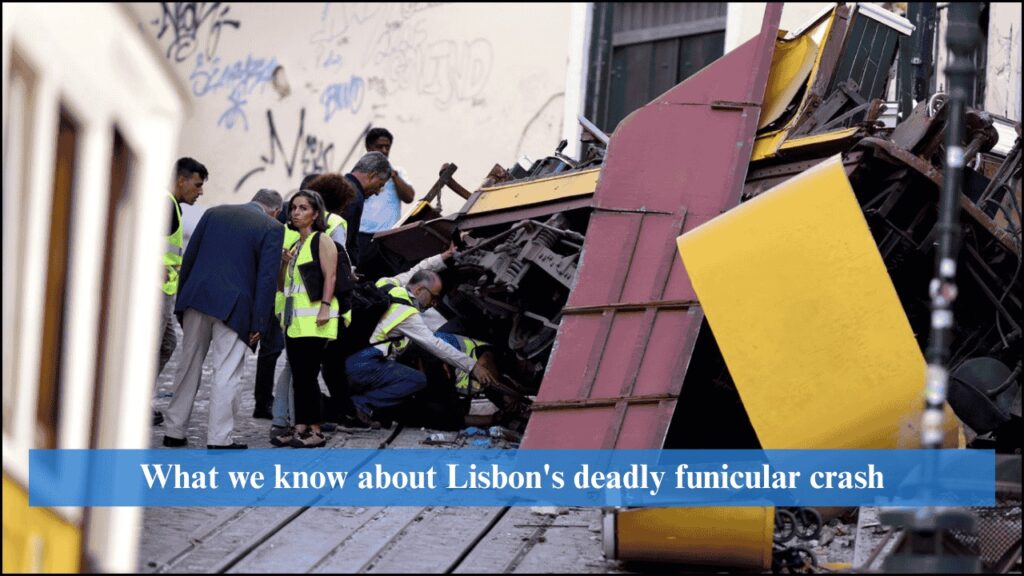
Lisbon has been left reeling after one of its most iconic funiculars, the Glória, derailed and crashed on Wednesday evening, killing 16 people and injuring 23 others. The accident, which occurred near Avenida da Liberdade, has shocked Portugal and prompted urgent questions about safety standards on the historic railway.
Table of Contents
How the Crash Unfolded
The crash happened at around 18:15 local time (17:15 GMT) on 3 September. According to local reports, a cable fault is suspected to have caused the carriage to lose control before colliding with a building on a steep hill.
More than 60 emergency workers and 22 vehicles rushed to the scene. Images showed the yellow tram-like carriage overturned and crumpled on the cobblestone street, surrounded by smoke and debris. Witnesses described chaotic scenes as people ran for safety, while others tried desperately to help those trapped inside.
Tour guide Marianna Figueiredo, who saw the crash unfold, said: “People started to jump from the windows inside the funicular at the bottom of the hill. When I climbed up, the only thing I could hear was silence. It was a big tragedy.”
Casualties and Survivors
Initial reports put the death toll at 17, but Prime Minister Luís Montenegro later confirmed 16 fatalities, citing a duplicate hospital registration error.
Among the dead are five Portuguese nationals, two South Koreans, two Canadians, an American, a German, a Ukrainian and a Swiss citizen. Three victims remain unidentified.
Twenty-three people were injured, including eight foreigners. Six remain in intensive care, while three sustained minor injuries. A German father was killed in the crash, while his wife was injured, and their three-year-old child was pulled alive from the wreckage.
One of the victims, André Jorge Gonçalves Marques, was an employee of Carris, the public transport operator that runs Lisbon’s funiculars. The company praised his 15 years of “exemplary service”.
The Glória Funicular: A Lisbon Landmark
Opened in 1885 and electrified in the early 20th century, the Glória funicular is one of Lisbon’s most famous transport systems. The line connects Restauradores Square in the city centre with the Bairro Alto district, climbing a steep 275-metre route in just three minutes.
The system operates with two carriages attached to opposite ends of a haulage cable. As one descends, its weight pulls the other up, a design that has made it both efficient and reliable for decades. The funicular is popular with tourists but also serves as a crucial transport link for residents navigating Lisbon’s steep hills.
Safety Record and Investigation
Carris has said all maintenance protocols were up to date. The last full overhaul took place in 2022, with interim work in 2024, alongside weekly, monthly, and daily checks.
Company head Pedro Bogas insisted maintenance standards had been “scrupulously respected” and confirmed that an external contractor had overseen servicing for 14 years. Nevertheless, prosecutors and transport regulators have launched a full investigation into the suspected cable fault.
The second carriage, which did not derail, was found intact just metres away from the wreckage.
National Mourning and Global Reactions
The Portuguese government declared a national day of mourning on Thursday, while Lisbon Mayor Carlos Moedas announced three days of mourning in the capital. “Lisbon is in mourning,” he said, offering condolences to the victims’ families.
President Marcelo Rebelo de Sousa expressed deep regret over the “fatalities and serious injuries,” while tributes poured in from around the world. Spanish Prime Minister Pedro Sánchez and European Commission President Ursula von der Leyen both sent messages of solidarity. Flags at the European Parliament in Brussels were lowered to half-mast.
Fabiana Pavel, president of a Lisbon residents’ association, told the BBC that the tragedy had shocked her community. “The funicular is vital for locals, especially people with reduced mobility, but it has become overwhelmed by tourists. At the time of the crash, there may have been parents with children returning from school.”
A City in Shock
As investigators work to determine the cause of the derailment, Lisbon is coming to terms with the scale of the tragedy. For a city where the funiculars are both a symbol and a lifeline, the crash has left deep scars.
For now, residents, tourists, and officials alike are united in grief, waiting for answers that will explain how a beloved historic railway could have turned into a scene of devastation.





